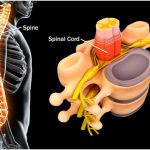Disorders and diseases of the Central Nervous System are complex to treat. They initially present with mild symptoms and gradually progress to unmanageable ones like unbearable pain, increased feeling of tingling and numbness, and loss of sensations in specific areas. The chief complaints of patients with spinal disorders include numbness, tingling, and pain radiating to the region where the compressed nerves are supplying. Advancements in spinal surgery have made it possible for surgeons to perform surgery at the affected site without causing significant damage to the surrounding healthy tissues. Spinal navigation technology is an advancement that allows the surgeon to access real-time, 3-D, and virtual images of the spine concerning surgical instruments intraoperatively. Other surgery options include Minimally Invasive Surgery (MIS) where the incision at the site measures around 2 cm. and the healthy tissues are spared, thus allowing faster healing times. Nowadays, high-quality treatments and hospitals in India have become synonymous in the medical fraternity around the world, with patients around the world having immense trust in the medical expertise of Indian doctors.
SPINAL IMPLANTS: ADVANCE BIOMATERIALS
Implants are artificial medical devices that are used to mimic the function of biological structures when the latter are damaged and no longer able to carry out their normal intended function. Implant manufacturers have made great advances in spinal implants manufacturing as the spine is prone to a variety of injuries and different surgical techniques can be employed to treat them. Biomaterials implants are the ones where biocompatible artificial things are used to treat different spine conditions. These implants are used to treat various conditions and achieve this through different mechanisms. The goals for different surgeries are varied and include fusion of vertebrae, stabilization or strengthening of the spine, correction of physical deformities like scoliosis, treatment of degenerative diseases like spondylolisthesis, and relief from pain due to spinal stenosis. The future of spinal implants is very promising as an increasing number of people are suffering from various spine-related conditions, including young people. Types of spinal implants include different devices made out of various materials. These include stainless steel, titanium, cobalt chrome, nitinol (a nickel-titanium alloy), tantalum, and polyetheretherketone (PEEK).
Spinal implants come in different forms. These include
-
Rods
These are some of the oldest of all implants that have been employed in spine surgeries. These are strong yet flexible and allow the surgeon to keep in a way to correct the problem of the patient.
-
Pedicle screws
These are specially designed screws that are placed in the pedicles of the spine, hence the name. Conventionally used for the lumbar spine, these are now being implanted in the cervical region also. Screws serve as anchorage points where rods are connected and contoured in a way to achieve the desired result.
-
Hooks
These are used along with rods and screws to anchor them to vertebrae.
-
Plates
These are mostly used in the cervical spine and are held in place with the help of screws placed in adjacent vertebrae.
-
Cages
Commonly referred to as interbody cages because of their placement in between two vertebrae, they pack BMP or bone graft to promote bone growth between the adjacent vertebrae. These cages are small hollow devices with perforated walls.
TITANIUM
Titanium biomaterials find innumerable applications due to their various advantages. These include their qualities of being lightweight, strong, flexible, biocompatible, and able to be alloyed with other metals; thus, making titanium a choice of biomaterial for implants. Both titanium and titanium alloys are used in the construction of biomaterials and are used in the form of screws, rods, plates, and cages.
BONE GRAFT
Bone graft is frequently used for spine problems. Approximately half of the bone grafts manufactured are used for spinal problems. Bone graft is principally used for the spinal fusion process. It provides the foundation for the natural bone to grow, thus fusing two bones and forming one long bone. Bone graft is one of the different types of materials used in spinal surgery, while many other materials are used depending on the condition. These include new materials that are being introduced regularly.
BMP
BMP, bone morphogenetic proteins, are proteins that stimulate natural bone growth in the human body and in the process mitigate the need to use the patient’s bone. They are usually employed in bone fusion surgery which involves the placing of these proteins in a concentrated form in the area where spinal fusion is intended. Spinal fusion surgery in India is commonly done in both domestic as well as international patients with excellent surgical outcomes.
CERAMIC AND CARBON FIBER
The use of ceramic and carbon fibers in biomedical applications has increased and is being used for a variety of purposes. Ceramics used for biological purposes are biocompatible and commonly referred to as bioceramics. The biocompatibility varies too, with some being inert while others being completely resorbable and eventually replaced by the body once they have assisted in repair. Some of these bioceramics are rigid and form part of surgical implants while others are flexible. With recent developments, it has been possible to make carbon fibers on a nanoscale and finds immense use in biomedical applications. These are used in regenerative medicine and cancer treatment. They also can be used as excellent scaffolds for the bone tissue to regenerate.
DISC REGENERATION
Disc regeneration is a complex process but in recent times a lot has been studied about it and much emphasis has been given on it rather than surgery. Intervertebral disc degeneration is one of the disabilities that contribute to major socioeconomic burdens around the world. It is a chronic, progressive process that is associated with aging. It has been associated with back pain for a long time and has been a target of intense research. Several materials have been introduced in recent times that aid in intervertebral disc regeneration. Biomaterials for intervertebral disc regeneration include those that have desired qualities of being biocompatible, lightweight, and durable and are carefully selected as per the patient’s needs.
MEDIFLAM- MEDICAL TOURISM IN INDIA
Spinal disorders are very common nowadays because of sedentary lifestyles and incorrect postures. Road traffic accidents also contribute to significant spinal problems in younger populations. Apart from common spine surgeries, spinal disorders’ other surgery treatments and hospitals in Indiaare varied and top-notch, and the most important thing, they are quite affordable when compared to advanced western countries. Good hospitals and experienced doctors abound in India. It becomes very difficult for an international patient to choose the best doctor and hospital that caters to his or her specific needs, thus creating further confusion. Medical tourism consultants in India bridge this gap because of their extensive knowledge, and in-depth study of different hospitals and doctors. MediFlam is a reputed name among medical tourism consultants in India. They have an expert in-house medical team that assists patients in making informed decisions while choosing doctors and/or hospitals that perfectly suit their needs.
FAQs REGARDING SPINAL SURGERY IN INDIA
Spine surgery cost in India varies on the location and number of sites involved for surgical intervention and varies anywhere from $2500 to $8000. Different doctors in different hospitals quote according to their experience and skills.
With the introduction of modern technologies, the spine surgery success rate in India has increased tremendously. Apart from success rates, recovery times have shortened because of incisions as small as 2 cms. are done at the site of surgery. Patients can go back home in around 2 days, decreasing hospital stay and consequences resulting out of it, and decreasing overall costs.
Depending on the type of problem, different types of spine surgeries are employed. Chief surgeries among these are laminectomy, discectomy, decompression, fusion or a combination of these. Spine surgery in India has evolved to a level where success rates have increased and recovery times have decreased, exponentially.
When a surgeon decides to operate on a patient, he does only when the benefits outweigh the risks and the quality of life (QOL) of the patient increases significantly. Quality of life after spinal fusion is improved greatly and the patient can lead a pain-free life.
Back problems occur in all ages but are usually common in the older population. This is because they have been subjected to more wear and tear. The age limit for back surgery is not defined and nowadays advanced technologies have made it possible that patients with advanced age can also undergo back surgeries.













